Keyword stuffing in a nutshell
When optimizing web pages for search engines like Google, it can be tempting to take the easy way out: using all kinds of manipulation tactics to quickly get higher rankings. Maybe you’re even thinking: “If search engines use keywords to match pages with search queries, then why not stuff as many of them as possible onto a single page to get it to rank for several highly searchable keywords?”
Unfortunately, it doesn’t work that way.
While stuffing does go great with a Thanksgiving turkey, it doesn’t do the same magic for keywords. As a matter of fact, black hat SEO tactics like keyword stuffing do you way more harm than good.
So, get a pen and notepad ready because it’s time to learn. In this article, we’ll cover everything you need to know about keyword stuffing in SEO.
Keyword stuffing: a naughty word that’ll get you in trouble
According to Google’s guidelines, the definition of keyword stuffing is, in simple terms, the practice of excessively filling a web page with keywords with the ultimate goal of gaming the search giant’s ranking system. There’s also a similar guideline on keyword stuffing provided by Bing.
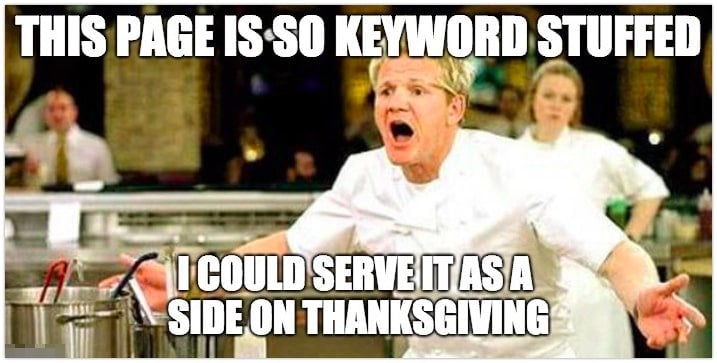
Back in the day, this practice was actually a rather successful way of boosting a web page’s search visibility, but search engines eventually outgrew it and started issuing keyword stuffing penalties – but more on that later.
Keyword stuffing examples
These days, many people in content creation and SEO keep stuffing their pages with keywords and they don’t even realize it. As a result, they suffer unexpected consequences.
Below are some examples of keyword stuffing to help you better understand what it is and how to tell if you’re doing it on your web pages.
Keyword stuffing can be broken down into two distinct groups: visible and invisible. Let’s take a closer look at each type.
Examples of visible keyword stuffing
If you’re unnaturally repeating a specific keyword or number multiple times out of context in a piece of content and your readers can see it, that’s visible keyword stuffing.
For example, let’s say a home appliance e-store is looking to get a web page quickly ranked high for the search term ‘best vacuum cleaner’. In this case, an example of keyword stuffing in the copy would be:
Looking for the best vacuum cleaner? You’ve come to the right place for the best vacuum cleaner. Our brand offers the best vacuum cleaner that you could want. Lightweight, yet powerful, this is the best vacuum cleaner for all your cleaning needs. Best vacuum cleaner.
As you can see, the term ‘best vacuum cleaner’ is used way too many times here. It’s even used out of context in some places, and in others it’s completely irrelevant to the main topic of the content. At the end of the day, no one will see this text and say ‘wow’.
Here’s another example of a web page that uses several closely-related keywords in its copy to get search engines to favor it in search. Now, although it isn’t as blatant as the example above, it’s still keyword stuffing.

Other examples of visible keyword stuffing include inserting text blocks that just repeat a keyword. There’s also link spamming, as shown in the screenshot below (which is, of course, just an example):
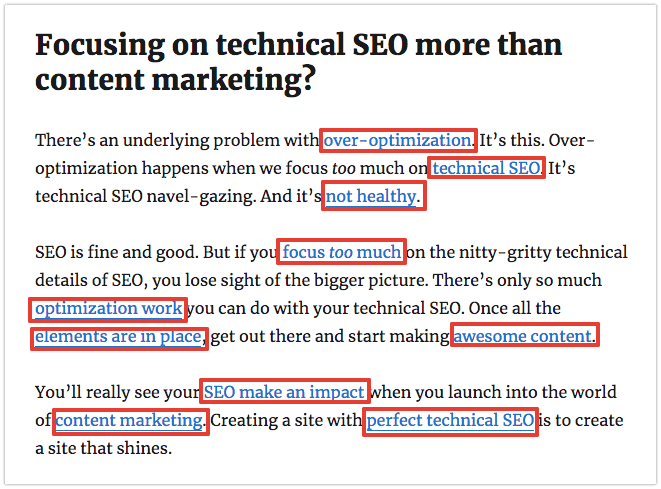
Link spamming is also known as spamdexing, and even though it may not be a direct keyword stuffing example, the idea behind it is the same. You’re trying to fill your content with various links, which is interpreted as keyword spamming by search engines and can lead to penalties.
Examples of invisible keyword stuffing
Some content creators are smart enough to know not to mess with their users’ page experience. So, instead of pushing keywords directly in front of their eyes, these creators might still create spammy, unreadable text, but simply hide it from the reader.
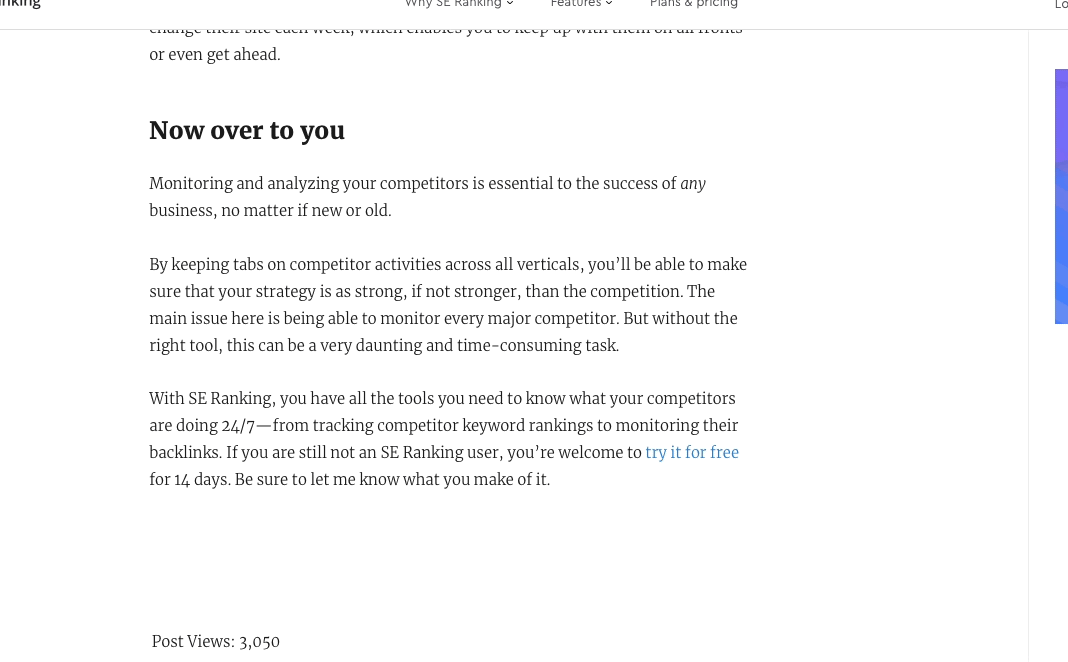
There are several ways to hide keywords from readers, but not from search engine crawlers. You could, for example, make the color of the text and background the same (as shown above), but web page text, no matter its color, style, or size, is still HTML. This means it will still be spotted by search engines when they crawl and index your web page.
You can also stuff the keyword in the web page’s HTML code, like in the comment, meta, and/or alt tag, but search bots will still find them.
The bottom line is this: when content creators practice keyword stuffing, they’re making a conscious decision to optimize their web page for search engines only and at the expense of their intended audience — people. And since search engines are designed to serve human readers, keyword stuffing tactics will be seen as manipulative. Search engines will likely penalize your web page in response.
Let’s focus on that last part in greater detail.
Can keyword stuffing help your website?
As a rule of thumb, stuffing your web pages with keywords definitely won’t help your search rankings; In fact, it can even harm your SERP standings. Keyword-stuffed content is simply unreadable and unhelpful to users, and search engines, naturally, favor pages that create a great experience for users.
Search engines state that keyword stuffing results in a negative user experience and can harm your site’s rankings.


As you can see, straight from the horse’s mouth, if you’re repeating the same keyword or number over and over on a page, there’s a good chance that Google and other search engines will penalize it by decreasing its rankings.
On top of that, besides being able to understand textual content, search engines also pay a great deal of attention to how searchers interact with web pages and their content.
For example, let’s say that somehow a newly-published keyword-stuffed page gets featured briefly at the top of the search results because of its use of visible black hat manipulation tactics. At the end of the day, people will leave it as soon as they see the mess inside. This will result in a high bounce rate, which will signal to search engines that the page isn’t giving users what they thought they’d get.
Of course, it wouldn’t be unfair to object and say that you’ve seen keyword-stuffed pages rank high on SERPs before, but don’t go running off to do it just yet. According to a John Mueller tweet:
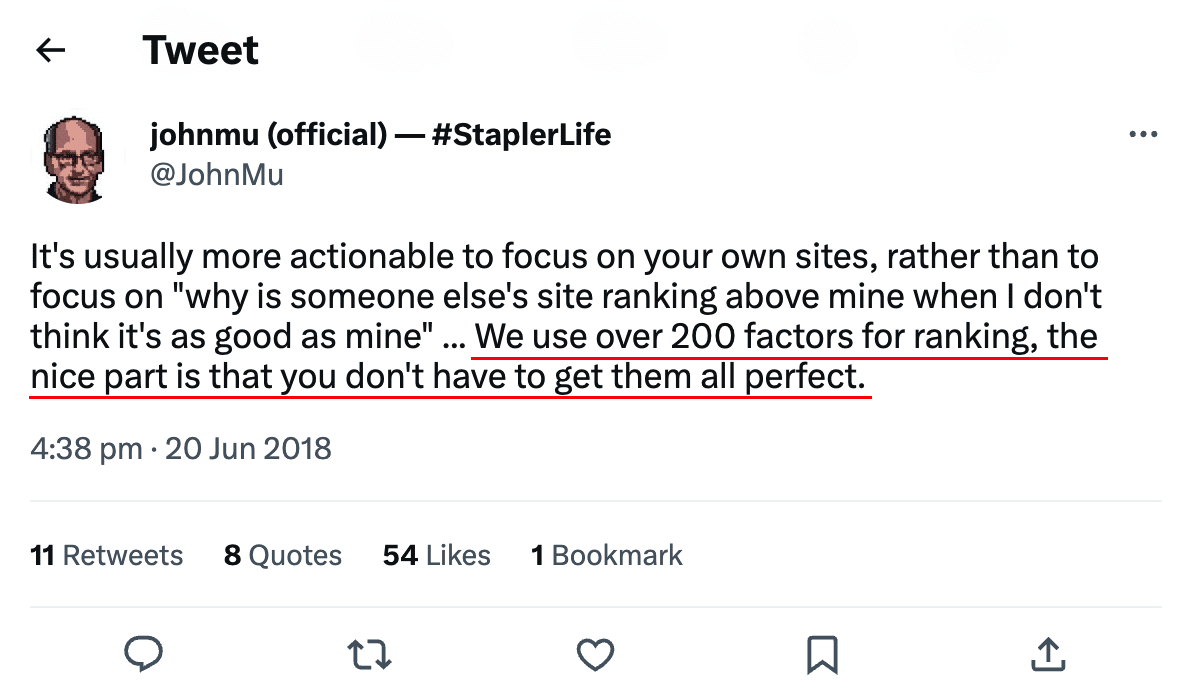
What you can draw from this discussion is that the use of keyword stuffing won’t actually hurt your web page that much, at least when it comes to SERP rankings. This is because search engines analyze a complex set of factors.
But if you see a keyword-stuffed web page ranking high in search, don’t assume that keyword stuffing helped it get there. It’s more likely that the page has achieved a high ranking despite being keyword-stuffed because it provides high value to users.
The idea behind keyword stuffing actually stems back to the days when you simply had to add keywords to your content to let search engines know what the text was about. But after multiple algorithm updates, including the release of the Hummingbird update, the search titan started understanding texts even better. Now it understands synonyms, typos, and what the user wanted to find when entering a search query, which is to say, the intent of the user.
What this means is that content creators should forget about using exact-match keywords and instead focus on producing naturally-written text. So, as tempting as it is, don’t force keywords into your content. You’ll have way better luck optimizing it the way both search engines and people want you to, which leads us to the final point.
How to avoid keyword stuffing
At this point, we’ve settled on the fact that keyword stuffing won’t have the decisive say in your web page’s search rankings, but keyword optimization will. So, let’s once again see what advice Google has to offer: “Focus on creating useful, information-rich content that uses keywords appropriately and in context.”
Keywords still need to be used (but moderately), so don’t let all this talk scare you away from using them in your content. To avoid keyword stuffing and improve your SEO, it’s important to focus on creating high-quality content that engages your audience. Write for humans, not for search engines, and conduct thorough keyword research to identify relevant keywords and phrases for your content.
Once you have your keywords, use them strategically in your content, but avoid overusing them. Use synonyms and related terms to diversify your content and avoid repetition. Providing value to your audience, for example, is a surefire and common sense way to improve your search engine rankings without resorting to keyword stuffing.
With the release of the BERT update and its subsequent MUM algorithm update, Google has refocused its attention to content created for human readers and not for search bots. So, if you’re thinking that Google will eventually go back to its old ways, you couldn’t be more mistaken.
To get a page to rank high for a specific keyword, optimize the page for that keyword instead of ‘stuffing’ it into your copy. The trick is using the keyword where it matters most for search engines, while keeping the text natural and valuable to readers.
It’s also crucial to structure your content in a way that provides more context for search engines. For example, use HTML heading tags (H1, H2, H3, etc.) to break up your content and make it more readable. You can also add your target keywords to your headers, as well as technical aspects of your site like meta tags and alt tags, but only where it makes sense to do so.
Let’s move on to the steps you need to take to properly optimize a web page for a keyword.
1. Use secondary keywords, synonyms, and long-tail keywords
To help search engines understand that your page is about the target keyword, it’s beneficial to use secondary keywords, synonyms and long-tail variations throughout your content. Using these keyword types gives search engines additional context, providing further evidence that your page covers the main topic.
Not only do long-tail keywords give more context but they also let search engines know that your content contains answers to relevant search queries. If it does, then your content might get featured in Google’s “People also ask” section.
Also, using synonyms in your content demonstrates relevance to Google and can improve your search ranking. Moreover, the use of synonyms confirms that you are writing content for people and not for machines.
Сreating a strong SEO keyword list starts with identifying high-quality, top-performing keywords. SE Ranking’s Keyword Suggestion Tool can come in handy here as well, as it enables you to input any keyword and gives you a list of related long-tail keywords and questions related to your topic.
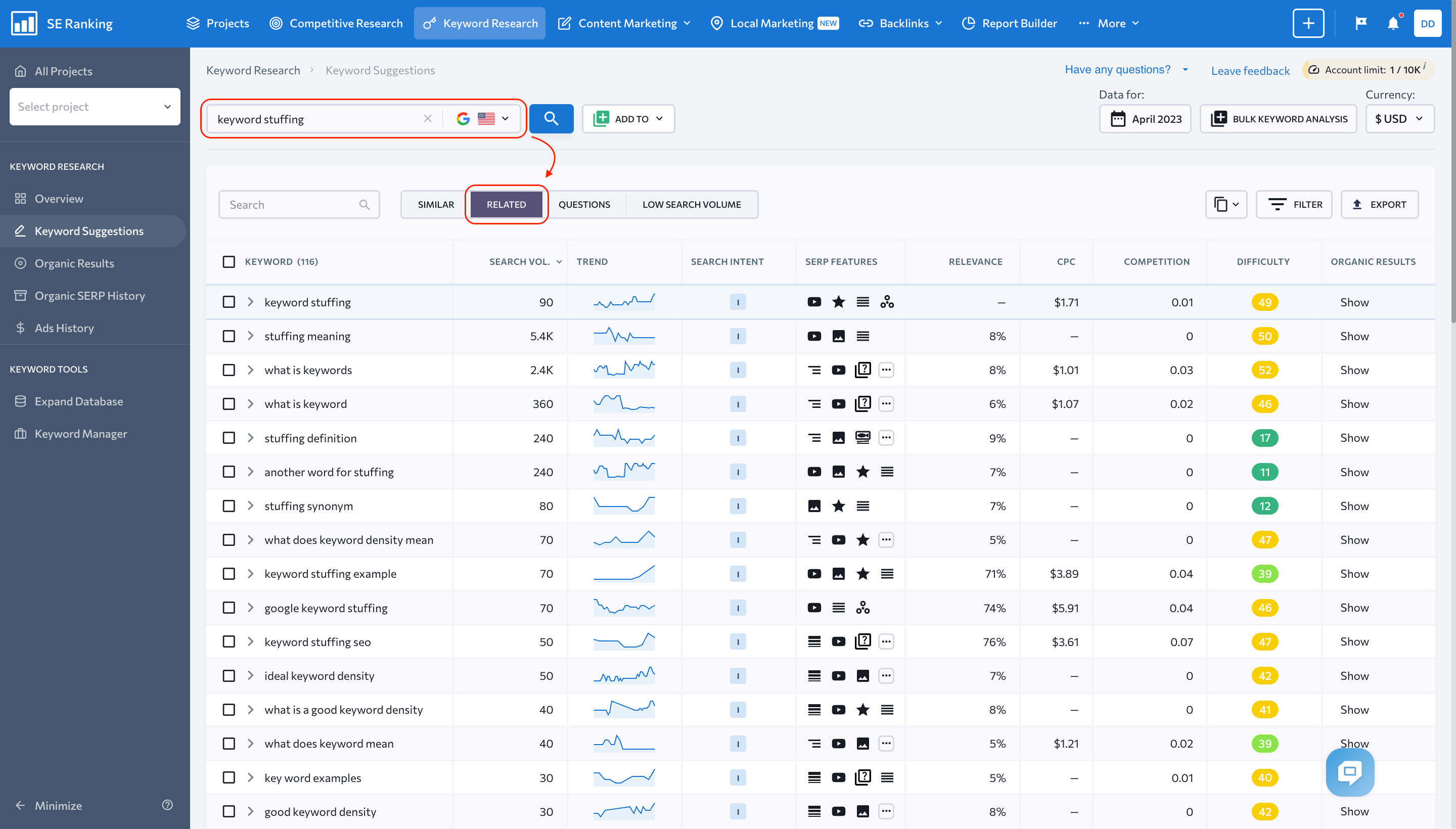
To improve content optimization for search engines, SE Ranking’s Content Marketing Platform can be a valuable tool. It features a powerful SEO Content Editor, which analyzes the content of top-ranking search results and enables you to find efficient ways to optimize your content. The tool provides recommendations on which and how many keywords to use, helps structure your article, and analyzes the content’s readability, grammar, and spam.
The SEO Content Editor also suggests content structure and provides suggestions for improving SEO, making it easier for you to create high-quality, optimized content that ranks well on search engines and engages your target audience.

2. Maintain a good keyword density
During content creation, try sprinkling the text with your target keyword, but try not to go overboard. Only insert the keyword where and when it feels natural. But still, you might be wondering how many keywords are too many in a single piece of content.
While there’s no strict rule on the appropriate number of times to use keywords in your content, try to check the keyword density and then keep within a safe range. Experts suggest that 2-5% is a safe range to stay within, but to rank higher in search results, you’ll find that the recommended keyword density varies depending on your niche and the level of competition in it. To find out what the recommended density is, research your top competitors and incorporate their keyword strategies into yours while keeping your content natural.
SE Ranking’s On-page SEO Checker enables users to optimize their own content’s keyword density. The tool provides a comprehensive analysis of your web page and identifies potential issues related to keyword density that may impact your page’s overall performance in search results. It provides recommendations on adjusting keyword usage throughout the page, helping you optimize it for the target keyword and avoid keyword stuffing.
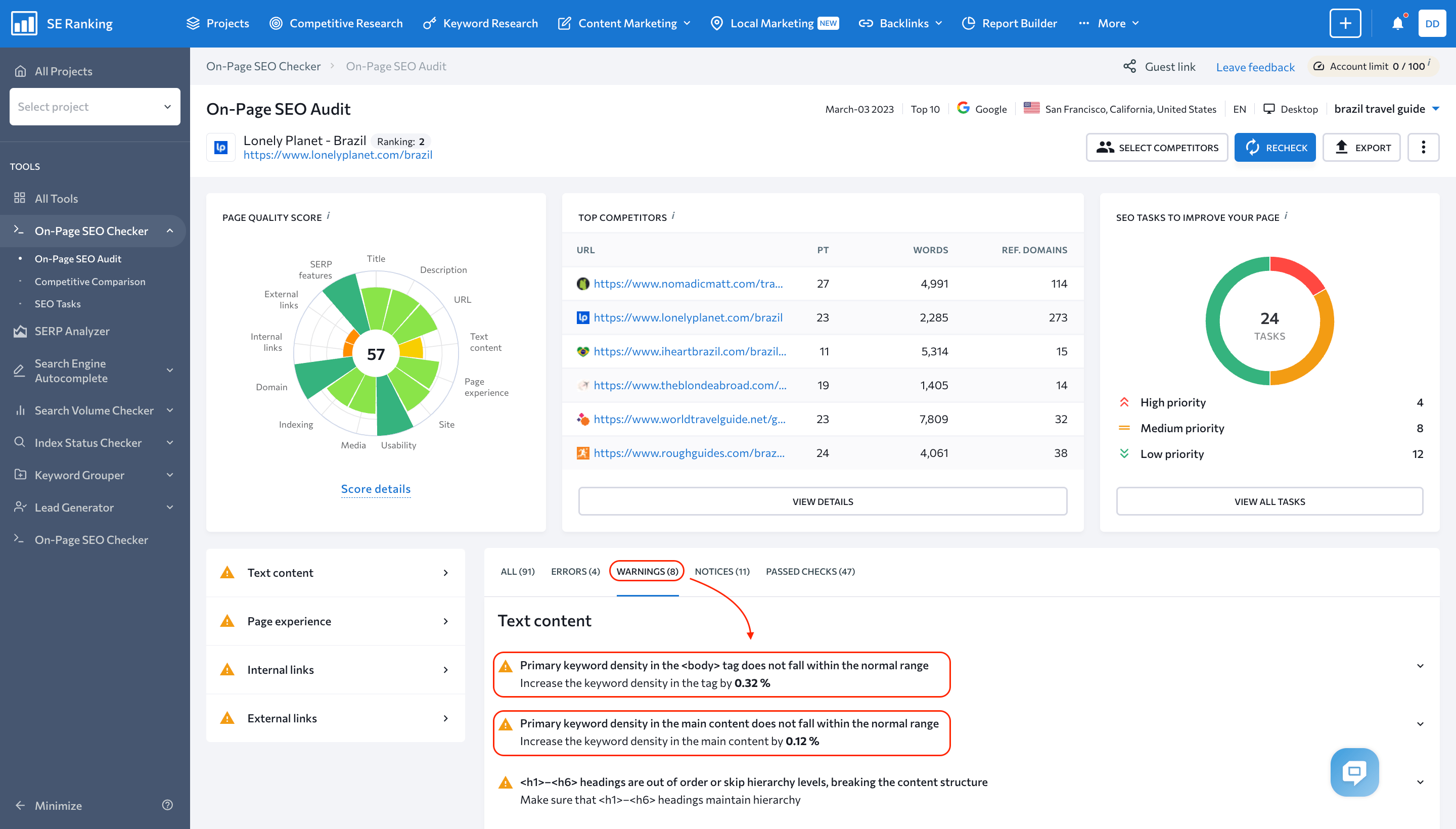
3. Add the target keyword to page elements
Another useful thing to do when optimizing a page for a keyword, according to search engines, is to add the target keyword to all the right places across your page elements. These elements include the page title, title tag, meta description, beginning and ending of the text, subheadings, and image alt tags.
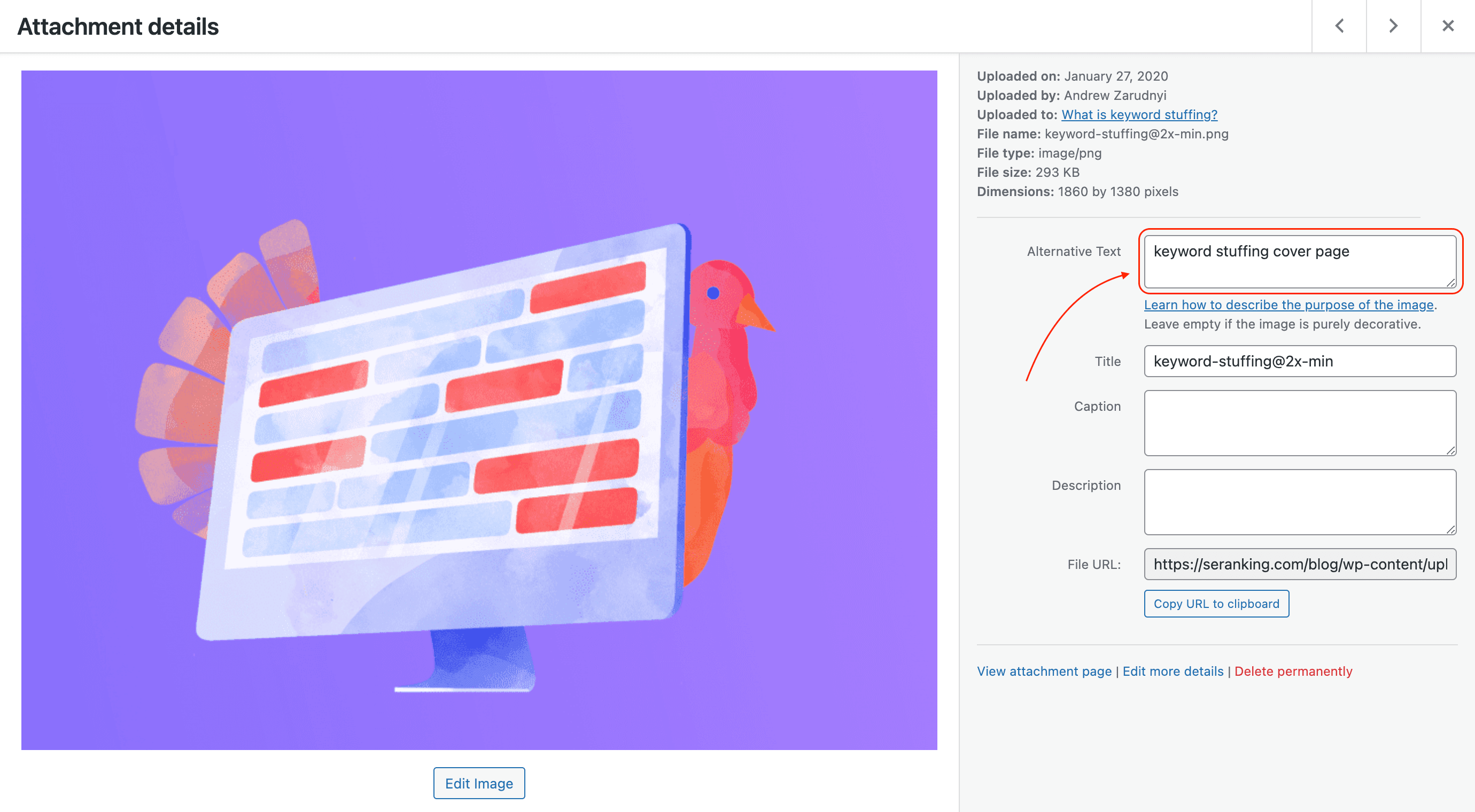
As opposed to keyword stuffing, when you optimize page elements, you’re strategically placing the target keyword in all the places that search engines use to understand the content’s topic.
And if the target keyword is present in both the body of the content and all metadata fields, this sends out a very strong and consistent signal to search engines that the main topic is covered in your content. This can increase the likelihood that the page will get ranked high for the right target search term in the SERPs.
Now over to you
Unlike keyword-stuffed pages that simply repeat vaguely defined keywords over and over with the ultimate goal of cheating and gaming ranking systems, keyword-optimized pages provide search engines with clarity about the page’s content. It makes it clear which search term the page should be displayed in search for. This helps your pages achieve higher rankings, and generates traffic that actually comes back to your site.
Take your time to do proper keyword research and prioritize creating high-quality content for human readers. Gone are the days of filling a page with keywords and enjoying high rankings as soon as tomorrow. These days, your focus should be on giving people exactly what they want.By following the tips provided in this blog post, you’ll soon be producing keyword-optimized (not keyword-stuffed) content! But to get there a little quicker, be sure to give SE Ranking a free 14-day try. You’ll love our keyword research and on-page SEO checking tools!
